Chris & Allyson vs. Australia (May 2012)
Day One: Arrival in Sydney. The Rocks. Exploring the Circular Quay. The Opera House.
My lovely wife Allyson and I decided to go to Australia. To be more accurate about it, Allyson decided to go to Australia, and I was informed that I could attend if so inclined -- though my absence in no way would stop her from going. It was a very healthy and adult conversation of the sort that you get to appreciate when you are past age 32.
To be fair, my wife had great reasons for wanting to visit Australia. About a year and a half earlier, a friend moved to Sydney, taking a job running a cancer research program. (They have cancer in Australia, too! It really is a small world.) If you aren't willing to spend $6,000 on a trip halfway around the world that lets you go to dinner with a friend two nights in a row, what kind of friend are you? Either a bad friend, or a friend without $6,000 and two weeks of vacation time saved up at your work. You jerk.
We also wanted to try this kind of adventure while we were young, while our bodies could handle the trip, before our professional lives got too hectic, and before it would cost $9,000 -- in the event that we decided to have a child that would never appreciate the fact that we had dragged him halfway around the world at a young age to see animals with pouches.
Anyhow, the big problem with Australia is that you have to get there. It is very far away, if you are traveling by 19th-century prison ship -- the most authentic method. If that's how you plan to go, you're going to need a very reliable friend to water your plants for the next year, and possibly to administer your will in the event that you die of some prison-ship disease. Science has come a long way toward treating scurvy, but we're still far away from a cure for the most serious prison-ship ailment: being stabbed in the face by a convict.
Even in a 747 or an A380, you're going to have to set aside a good day or so to get there. You'll get the day back when you cross the international date line on your way home, but it's going to be confusing for a bit. (That's the other big problem with Australia: it involves time travel.) We opted to fly Qantas to get there, because it's a good Australian company. They make this abundantly clear, by painting huge kangaroos on the tails of all their planes.
Not to jump too far ahead (like a kangaroo! Ha!), but we might as well address this: You're going to see a lot of kangaroo stuff on your trip to Australia, and you should feel free to gawk.
Now, it doesn't seem like gracious guests would drool over kangaroos -- after all, no one would find it amusing if you asked for directions to the nearest Outback Steakhouse while doing a Steve Irwin impression and drinking a Fosters. (We saw no Outbacks, and Australians hate Steve Irwin and Fosters, which is Australian for "the garbage we export because no one here can stand it, and bear in mind that we even have a taste for Vegemite," mate.)
Heading to Australia, it seemed like kangaroos (and koalas, and platypi) were part of the stereotype. You'll want to be excited about them -- we don't have marsupials in America, and the thought of animals with pouches is very exciting to those of us who can never find our keys -- but you might think it's polite to hold back.
Well, don't sweat it, because Australians are cool about you wanting to see marsupials. Half their coin currency has marsupials on it, 75 percent of Australian businesses incorporate kangaroos into their logos, and a number of prominent members of the Australian Parliament, including Prime Minister Julia Gillard, are kangaroos. They're really proud of the things, so that's one stereotype you can indulge.
So. In May 2012, we took a Qantas flight from Los Angeles to Sydney, which is about 14 hours. That sounds like a long time, but Qantas has a routine. You get on the plane, and after a few hours they feed you. Then they shut off the lights and tell you to go the hell to sleep. About two hours before landing, they wake you up, feed you breakfast and shove you out the door at 9 a.m. Australia time. If you can't sleep on a plane, they have "on demand" video systems in every seat, which have access to every movie made in the last 3,000 years, approximately. You could literally watch seven movies in a row to pass the time.
On a related note -- did you know that everything in Australia is really expensive? It is. For example, a regular movie ticket costs about $22 American. When you're on a Qantas flight, you might notice a lot of Australians on the plane with you. They are actually not traveling anywhere; they just want to catch up on their movies, and it is cheaper to fly round-trip to Los Angeles over the course of one weekend than to pay to see 14 films in the theater.
The flight was much better than we were expecting, with only two crying babies -- and even those babies added value to our trip, as they inspired me to devise the first ever humane, sound-proof overhead storage bin for the sequestration of crying babies. As I mentioned, we arrived in Sydney at around 9 in the morning.
Now, as you are spending $6,000 for two weeks in Australia, you don't want to spend too much of that trip in a babbling, jet-lagged haze. The standard advice is to force yourself to stay awake until 10 p.m., to get your body on Australian time. The people at our hotel strongly agreed with this advice, and they took a tough-love approach to enforcing it by not allowing us to check in at 9:30 a.m. And since we were new in town, we weren't sure which curbs would be safe to sleep on. We had no choice but to stay awake, so the first thing we did in Australia was to go for coffee. There was a place about a block away.
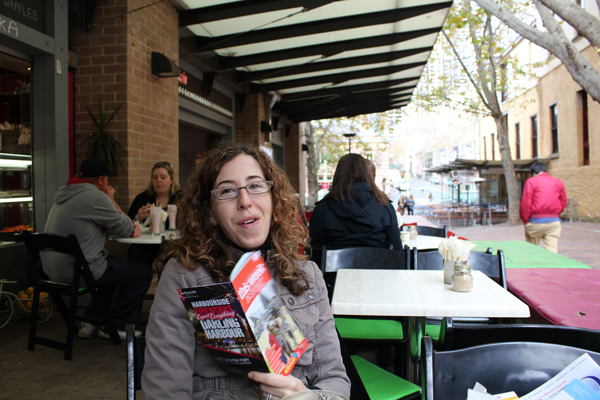
She'll have an ... Americano? Oi?
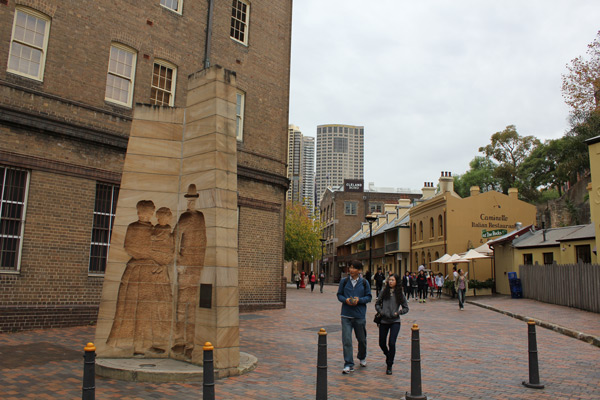
A monument to the olden days, in The Rocks.
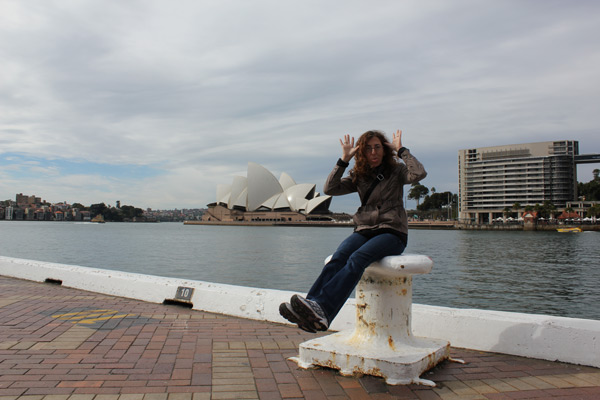
Getting familiar with Sydney Harbor.
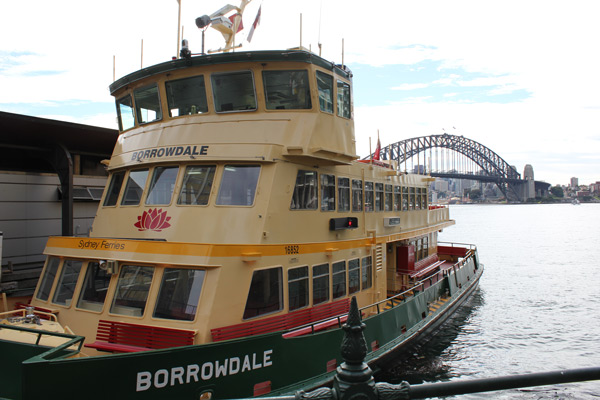
The world-famous Sydney Harbor Bridge. More on this later.
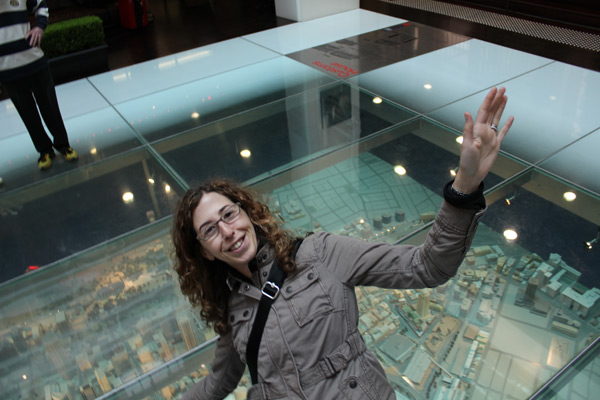
In the old customs house, a model of Sydney.
It's hard enough to order coffee after flying 14 hours, but in Australia you can't even order "coffee." If you say "coffee" in America, they will bring you a black coffee. If you are in Latin America, just say "coffee" while sounding like a gringo, and they will bring you a black coffee. If you are in Australia, you must take a three-month intensive barista work-study training course, followed by a 10-year apprenticeship at a mining camp mess hall in the Outback, followed by post-graduate work in coffee studies. Then, and only then, will they teach you the terms that you must know to order a black coffee.
I don't usually drink coffee, so I didn't really care. But Allyson's blood-coffee level is usually around 0.4. As she was severely jet-lagged, it was very entertaining watching her try to order the one substance that might help her brain work well enough to figure out how to order. I've never tried to explain string theory to a golden retriever, but if I did, I might once again see the expression I saw on Allyson's face that morning. It will make me think of Australia, and I will smile. (Note to self: learn string theory.)
As we drank our coffee, we figured out what to do with our day. For this purpose, we had a Fodor's guide to Australia, a handful of brochures, and a street map of Sydney printed in Chinese, since the English versions at the airport were all gone. I was very interested in visiting the Forbidden City, but as I cannot read Chinese, we instead decided to start our grand vacation with a walking tour of our hotel's neighborhood. Because the tour office was about 50 feet from the coffee place, mostly.
We were in an excellent neighborhood known as The Rocks, which is really where Sydney started. As I hinted earlier, and as you may have learned from that episode of "The Simpsons" where they went to Australia, the British originally used Australia as a penal colony. During the Industrial Revolution, there was a big spike in crime spike as cities started to fill up, and the empire had lots of foreign holdings with some labor-intensive job openings. Being a wise and judicious people, they figured that anyone caught trying to steal a hairbrush should be put on a boat for eight months, dumped at the bottom of the world and forced to build crap for the next 10 to 30 years of their lives.
The first ships landed in the 1790s in Sydney Harbor -- it was sheltered from the ocean, stunningly beautiful, and not far from where fresh water was tricking down from the hills. They didn't have prisons back then, but since there were no other cities, no roads, mysterious indigenous peoples and 10 unspeakably deadly kinds of snakes toward the middle of the continent, no one felt the need to run away. The first governor, Arthur Phillip, pointed at a big rock outcropping with a grand view of the harbor, and he said, "you dudes can go live over there." Which they did, because they were convicts and they didn't have much choice.
The convicts built their homes (and bars, and opium dens, and brothels) in The Rocks, stacked up and cramped in classic slum style. All the government and high-society precincts started to take shape a short walk away, around the harbor. The neighborhood was blue-collar and gritty, and the history reflects it. Our guide told us about the construction of the city, the street gangs that used to operate out of the small, dark alleys (the word "larrikins," once used to describe gang members from The Rocks, is now Australian slang for "you little rascal"), the old Victorian architecture and the shipping-related commerce that filled up all the cramped little courtyards. We saw the oldest home in Australia, "Cadman's Cottage," not too far from the water's edge. John Cadman was a convict in charge of watching over the government's boats. He had stolen a horse. Many of the foundations of old buildings have been preserved, so you can see how people clung to this giant sandstone lump like barnacles on a reef. As they carved out streets, they used the sandstone to build their homes.
And let's not forget the rats. In the 1920s, there were scads of the critters, which might have contributed to a plague outbreak which killed 103 people in Sydney. As part of the response, the government ended up acquiring tons of Rocks real estate to try and sterilize the area. That land grab in turn made it easier for the government to build the Sydney Harbor Bridge -- they had no problem clearing out old slums to put one end of the bridge in the Rocks. It is now part of the busiest road in Australia.
Adding to the fun of the neighborhood were the nearby docks, and the kinds of people who hang out around docks. One of the cool older buildings is the Sailors Home, a kind of YMCA for whalers who wanted to avoid the massive amounts of whoring and gambling nearby and just get a good night's rest before heading off to kill more whales.
Gritty, blue-collar living takes a toll on a neighborhood, and by the 1970s, the government was ready to go Old Testament on the dirty, disgusting remains of The Rocks. However, the dirty, disgusting residents were unified by various community activists -- one union boss named Jack Mundy in particular. They fought for historic preservation, saved a ton of the homes, and gradually watched the entire neighborhood turn around. Today it's a thriving little section of town, convenient to the harbor ferry terminal, packed with museums and pubs and art galleries, and almost 100 percent plague free. If you're going to visit Sydney, there might not be a better location for you to operate out of. It's convenient to everything.
All the information above is courtesy of superguide Vicky at The Rocks Walking Tours. I'm sure she gives a great tour under any circumstances, but we got the deluxe treatment thanks to small numbers. May isn't the tourist season in Sydney, and Monday morning isn't the busy part of the week. The tour group consisted of me, Allyson and Jackie -- a nice lady from Brisbane with a fear of heights. Her husband and kids were off climbing the Sydney Harbor Bridge (more on that later), and she needed to kill some time. She gamely put up with all the questions from the punchy Americans and asked some questions of her own.
You hear legends of how friendly Australians can be, and we weren't disappointed -- right after the tour ended, Jackie still had time to kill, so she invited us to have a coffee with her. We went to what was (probably) a 19th-century-whorehouse-turned-cafe, sat down with a relative stranger and had a really nice chat. She and her husband had been trying to show the kids all around Australia before they got to college age, and in true teenage fashion, the kids were starting to be sullen and unappreciative snots. This was probably the last family vacation in a while, she said. Having confirmed that teenagers everywhere are basically the same, we had an international bonding moment and laughed about it. And then I sipped my "iced coffee," which is Australian for milkshake.
At that point, we had 10 or so hours to go before we could collapse in a heap. So we walked around the heart of downtown Sydney. Circular Quay is where all the ferries go, whether it's the tourist ferries taking people to the zoo or the commuter ferries bringing people to work. It's like an open-air bus station for boats. Like any good bus station, it offered an authentic cultural experience: within seconds of our arrival, we were enjoying an aborigine playing didgeridoo into a microphone, over top of techno beats. Yeah.
We stopped in the old Customs House, which is now a library. A lady on the Qantas flight had recommended it because it has a "really cool model of the city" -- and sure enough, under a glass floor near the main entrance was a really cool model of Sydney. Just hours into our journey, we were able to plan out our route in the event that we were exposed to radiation, made to grow to giant size and then enraged into a city-destroying rampage.
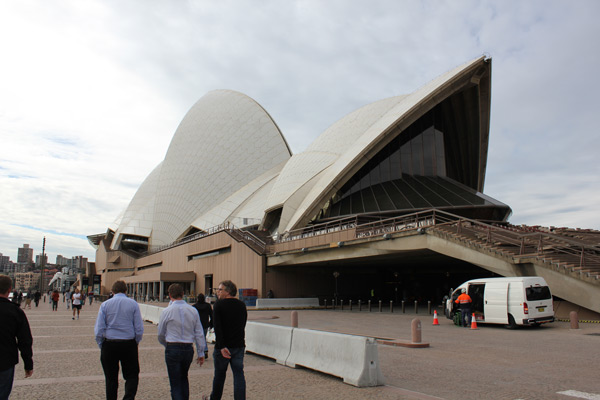
The Sydney Opera House. Attendance is mandatory.
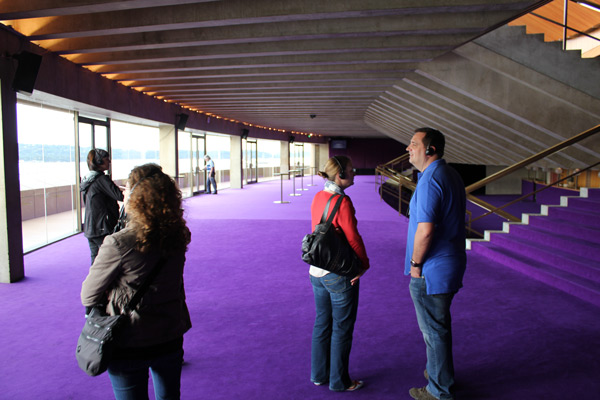
A concourse in the opera house, decorated in STYLE!
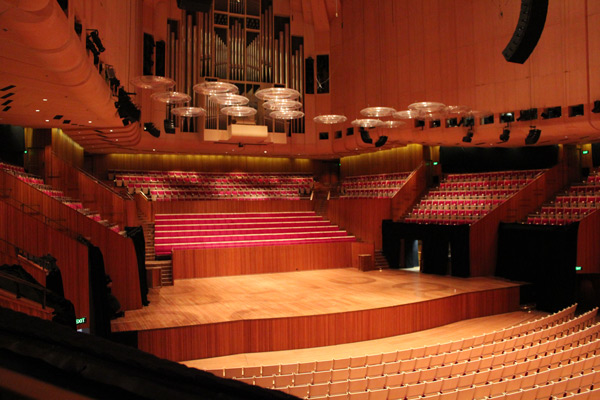
A famous concert hall in one of music's most famous venues.
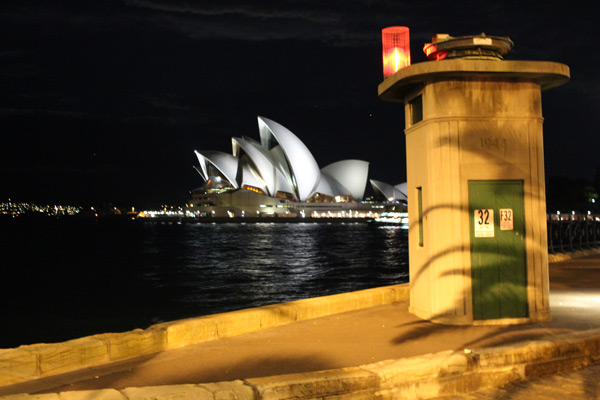
A nighttime view of the Opera House, across the harbor.
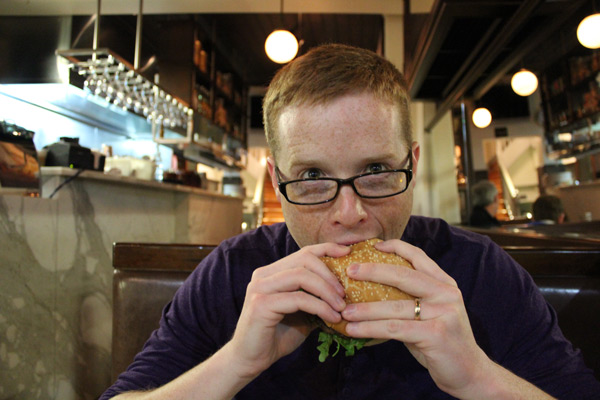
Jumping all over a kangaroo burger.
And then, because it's the law, we walked over to the Sydney Opera House. You can't escape the Opera House, so better to embrace it early in your visit. They put it at the center of everything. Bennelong Point juts out into the harbor just to the side of the Quay, so every ferry ride or harborside path gives you an amazing view. It looks good in sun and rain, and they light it up at night. It's right next to the city gardens, seconds from restaurants and minutes from the shopping districts. If you go to Australia and take 1,000 pictures, when you get home you will find that the Sydney Opera House and the Sydney Harbor Bridge are in 850 of those pictures. Even the pictures not taken in Sydney -- that's how prominent they are.
The building itself is absolutely striking, and its construction is absolutely legendary. A salty Danish guy named Jorn Utzon won a design competition, based on some very rough sketches showing the now world-famous "sail" concepts. No one had seen such a design before, which is why no one knew how to build it, including Jorn Utzon. He landed the sweetest architecture gig in the world with a cocktail-napkin doodle.
They started pouring the foundations before anyone had actually figured out whether the shell could be built. On the tour, they try to explain Utzon's revelation: large concrete ribs could somehow be cast as part of a sphere, then assembled on-site into the building's sails. This did not really "explain" the solution to me, but they were very emphatic that it was remarkably brilliant. Like all great and brilliant ideas, it went massively over budget and schedule. They had to institute a state lottery just to pay for the damn thing, and before the project was over they actually fired Utzon and brought in some faster managers to wrap things up. He was pissed, went to Daneland (or wherever Danes are from) and never returned to see his building -- which is arguably the most recognizable in the world.
There is a happy ending. When they decided to do renovations in the 21st century, they made nice with Utzon and hired him to plan them, so that the original aesthetic of the Opera House would be preserved. He worked from his homeland and died a few years ago, but they're still building based on his plans, whenever they can find the money. The original budget for the building, back in the 1950s, was something like $7 million. Renovations are estimated to run in the $1 billion range. Progress is a wonderful thing.
The tour takes you through the various performance spaces (they do a lot more than opera there), and the interior is a kick -- since it was finished in the 1970s, the carpets and seats are awesomely intense purples, blues and reds. We watched a little bit of a ballet rehearsal, and Allyson sat in the same seat Queen Elizabeth used during her last visit, in the main music hall. It is home to many orchestral productions, but most important, it once held the finals to "Australian Idol."
The rest of our jet-lag day is fuzzy, in hindsight. We managed to check into the hotel, stroll around the neighborhood a little more and buy crackers in a convenience store. We headed back out for dinner, and because our Northern/Western Hemisphere brains were feeling the pain, it took us an hour to eventually pick a small place about one block from our hotel. I know from my notes that I had a kangaroo burger.
And I do remember enough to tell you that restaurants are different in Australia, because there's no tipping. Apparently servers aren't paid crap wages, so there's no need to toss around your kangaroo-covered change. On the one hand, it's nice to see people getting dignified compensation for honest work. On the other, there is absolutely no motivation for anyone in an Australian restaurant to suck up to you. In America, we expect fawning service within seconds, free bread, enough water to make the desert bloom, a non-stop torrent of soda refills and people asking us how our meals are 30 seconds before we've had the chance to take the first bite.
In Australia, they will not give you water unless you ask -- they had a drought for about 12 years. If you want anything after they've brought your food, you'll need to ankle-tackle a server or set off a signal flare. But you probably won't want to do that, because every refill (even coffee, if you can figure how to order it) costs money. Lots of money. In fact, everything on the menu costs lots of money, as the cost of respectable wages is passed on to you. For a fun-loving, beer-chundering people, Australians have made it extremely expensive to have two beers at dinner for less than the cost of a small beach home. Two people having just main courses and one drink each will probably drop about $60 in Sydney.
My advice: You're on vacation, so put it all on the plastic. Handing over koala bucks would just be a physical reminder of how much you just dropped. One of the things Australians always say is "no worries," so take that to heart and leave your stroke-inducing rage attack for America, when you pay the credit card bill weeks later. It's the polite thing to do as a cultural ambassador to our friends down under.
